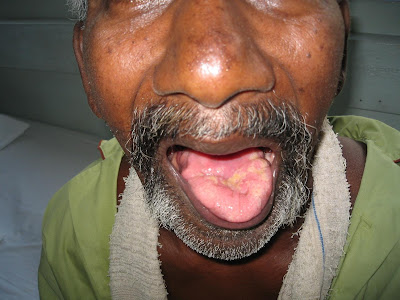
This is a low power image of a peripheral nerve in GBS. It has been stained with a myelin stain (pink). Note the large areas of myelin loss in the center

The interesting about Neurology is that the history(eg pt with headache) & examination is still plays a very important role. In cardiology, Echo has sort of replaced cardiac examination, U/S abd and CT abd has sort of replaced gastroenteralogy cases and chest radiograph and CT has sort of replaced respiratory examination.
Well, I say sort of because it should not be the way and physicians and all doctors should be pasionate about the power of history taking and physical examination.
You may say that MRI brain has replaced Neurology but it is totally untrue because the most important question in Neurology is where is the lesion ? So, if you MRI the brain for a Guillain Barre syndrome then you are in the wrong direction !
Which now brings me to the topic of to locate the lesion
You are asked to examine a 33 years old man with weakness of the lower limbs in the exam.
How to start ?
Inspection - wasting of the thighs, no fasciculations, no scars
Tone - reduced bilaterally
Power - 2/5 distally and 3/5 proximally
Reflexes - absent bilateral knee and ankle reflexes
Plantar response - downgoing bilaterally
Cerebellar examination of lower limbs not able to be done in view of the weakness
Sensation - reduced pin prick bilaterally up to the knees
Gait unable to be test due to the power
SO, the first conclusion you should make is
this patient has LOWER MOTOR NEURON lesion of the lower limbs with peripheral sensory neuropathy
Next step is to locate the lesion.
It is anywhere from the anterior horn cell , nerve roots, plexus, peripheral nerve, neuromuscular junction, muscle.
It is not the ant horn cell or neuromuscular junction because of sensory involvement. It is at the peripheral nerve because of predominant distal neuropathy with distal sensory involvement.
So, this patient has peripheral motor sensory neuropathy (predominant motor).
Next are the causes of predominant motor peripheral neuropathy
Causes include :
Guillain Barre syndrome (acute)
Chronic inflammatory demyelinating neuropathy (chronic)
Charcot Marrie Tooth/Hereditary motor sensory neuropathy
Lead poisoning
Acute intermittent porphyria
This patient actually has Guillain Barre syndrome.
So, you can see how important your examination is and from there you can actually investigate treat the patient. MRI brain will be useless.
You could do an LP to look for cytoalbuminaemic dissociation and a nerve conduction study.
If you suspect GBS, examine the pulse for tachycardia(autonomic dysfunction) and cranial nerves(weakness of the facial muscles).
Also you could do a vital capacity to look for respiratory involvement.
Treatment would be IVIG or plasmapheresis (more effective if given early)


 Station 5 PACES spot diagnosis in skin station ! Remember the criteria of diagnosis, so do not forget to check for Rinne/Weber if there is a tunning fork nearby and also ask for permission to ask about family history.
Station 5 PACES spot diagnosis in skin station ! Remember the criteria of diagnosis, so do not forget to check for Rinne/Weber if there is a tunning fork nearby and also ask for permission to ask about family history.















































